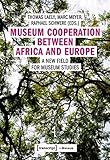Museum Cooperation between Africa and Europe : A New Field for Museum Studies / ed. by Raphael Schwere, Marc Meyer, Thomas Laely.
Material type: TextSeries: Edition Museum ; 33Publisher: Bielefeld : transcript Verlag, [2018]Copyright date: 2018Description: 1 online resource (272 p.)Content type:
TextSeries: Edition Museum ; 33Publisher: Bielefeld : transcript Verlag, [2018]Copyright date: 2018Description: 1 online resource (272 p.)Content type: - 9783839443811
- Museum cooperation -- Africa -- Congresses
- Museum cooperation -- Europe -- Congresses
- Museums -- Africa -- Congresses
- Museums -- Europe -- Congresses
- (New) Museology
- African Studies
- Cultural Management
- Heritage Studies
- Museology
- Museum Management
- Museum
- Postcolonial Theory
- ART / Museum Studies
- (New) Museology
- African Studies
- Cultural Management
- Heritage Studies
- Museology
- Museum Management
- Museum
- Postcolonial Theory
- 069.096 23
- AM80 .M87 2018
- AM80 .M874 2018
- online - DeGruyter
| Item type | Current library | Call number | URL | Status | Notes | Barcode | |
|---|---|---|---|---|---|---|---|
 eBook
eBook
|
Biblioteca "Angelicum" Pont. Univ. S.Tommaso d'Aquino Nuvola online | online - DeGruyter (Browse shelf(Opens below)) | Online access | Not for loan (Accesso limitato) | Accesso per gli utenti autorizzati / Access for authorized users | (dgr)9783839443811 |
Frontmatter -- Contents -- List of Figures -- Acknowledgments -- Preface -- Heterodoxy and the Internationalisation and Regionalisation of Museums and Museology -- Building a Critical Museology in Africa -- Introduction -- Introduction: Rethinking Museum Cooperation between Africa and Europe Do we need a new paradigm? -- PART I. Mapping the field – the history and context of Museum Cooperation between Africa and Europe -- 2. Connected by History, Divided by Reality. Eliminating Suspicion and Promoting Cooperation between African and European Museums -- 3. Cooperation between European and African Museums: A Paradigm for Démuséalisation? -- PART II. Local communities and international networks – relations of partnership? -- 4. Shifting Knowledge Boundaries in Museums. Museum Objects, Local Communities and Curatorial Shifts in African Museums -- 5. Who Shapes the Museum? Exploring the Impact of International Networks on Contemporary East African Museums -- 6. The Road to Reconciliation. Museum Practice, Community Memorials and Collaborations in Uganda -- PART III. Accessibility of collections from Africa -- 7. The Junod Collection. A new Generation of Cooperation between Europe and Africa -- 8. The Africa Accessioned Network. ‘Museum Collections make Connections’ between Europe and Africa: A Case Study of Finland and Namibia -- 9. The Hazina Exhibition. Challenges and Lessons for International Museum Collaboration -- 10. Artworks Abroad. Ugandan Art in German Collections -- PART IV. Critique and evaluation of museum cooperation -- 11. New Considerations in Afro-European Museum Cooperation in Africa. The Examples of PREMA and Other Initiatives in Ghana -- 12. Investigating Museum Development in Africa: From Museum Cooperation to the Appropriation of Praxis -- 13. Conservation and Restoration as a Challenge for Museum Cooperation. The Case of the Palace Museum in Foumban, Cameroon -- Conclusion -- 14. What are the Opportunities, Challenges and Modalities for African and European Museum Cooperation? -- Index -- List of Contributors
restricted access online access with authorization star
http://purl.org/coar/access_right/c_16ec
At a time of major transformations in the conditions and self-conceptions of cultural history and ethnological museums worldwide, it has become increasingly important for these museums to engage in cooperative projects.This book brings together insights and analyses of a wide variety of approaches to museum cooperation from different expert perspectives. Featuring a variety of African and European points of view and providing detailed empirical evidence, it establishes a new field of museological study and provides some suggestions for future museum practice.
Mode of access: Internet via World Wide Web.
In English.
Description based on online resource; title from PDF title page (publisher's Web site, viewed 26. Aug 2024)


